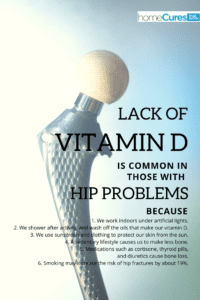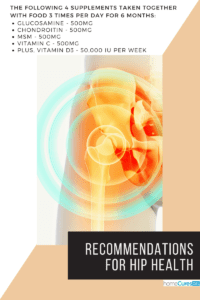Natural Remedies To Keep Hips Healthy And Avoid Hip Replacements
“Grandma fell and broke her hip!” is an all-too-common phrase in our society. People fear this because it often indicates the beginning of the end. Hip fractures lead to immobility and loss of function, which cause blood clots and other health problems.
Now, it isn’t always a broken hip that puts someone in the hospital for replacement surgery. Painful arthritis of the hip can make a person immobile and produce all the same hip problems necessary for surgery.
As the world’s population ages, one of the chief concerns of the aging is the health of their hips.
There are two main hip issues I want to address in this article:
- Hip Arthritis
- Hip Fractures
The hip is the joint between the femur (thighbone) and the pelvis. You can see that it is a ball-and-socket joint that gives stability with lots of motion. It’s a brilliant design!
Hip Arthritis
Most arthritis of the hip is simply a wearing-down of the cartilage that covers the bone and keeps the joint moving freely.
One of the most debilitating forms of arthritis is that of the hip. This joint supports all your weight with every step, and when the bone is directly rubbing on bone it is extremely painful.
The pain of hip arthritis is not on the side of the hip, but rather in the groin, especially with walking, standing, or bearing weight.
Pain on the side of the hip is most often a different problem, such as bursitis, muscle strain, or tendonitis.
As the pain gets worse, the person becomes more inactive, leading to osteoporosis, and decreased repair of the hip joint. Inactivity also leads to blood clots in the legs. The combination of inflammation and inactivity can cause clots to form in the large veins of the legs, called deep-vein thrombosis (DVT). These clots can break off and travel through the veins to the heart and lungs, clogging the circulation. If the clots are large, they can cause death.
Another reason to keep your hips healthy is to prevent death. Arthritis of the hips is associated with a 43% increased chance of dying.[1] This is probably due to inactivity – if your hips hurt, it’s much harder to exercise and stay functional. Hip fractures also increase the chance of death. The number of hip fractures is growing exponentially. It is estimated that 1 in 3 women and 1 in 12 men will get a hip fracture in their lifetime.[2] Surgical repair of a fracture gives the patient a 6% chance of dying from the surgery.[3] Within a year the mortality rate after a hip fracture increases by up to 58%![4] Even if there is a fracture, being steady on your feet is essential to recovery and being able to walk again, so preventing hip arthritis is essential.
Hip Fractures
“Hip fractures” are rarely in the actual joint because they are fractures of the femur. Depending on how the bone is stressed, it will fracture in different locations, creating different hip problems.
Signs and symptoms of a hip fracture include:[5]
- Inability to move immediately after a fall
- Severe pain in your hip or groin
- Inability to put weight on your leg on the side of your injured hip
- Stiffness, bruising and swelling in and around your hip area
- Shorter leg on the side of your injured hip
- Turning outward of your leg on the side of your injured hip
Causes of fractures are many. Stronger bones tend to have fewer fractures, but even young people with strong bones can get them.
Stress Hip Fractures
Stress fractures are caused by repetitive injury. When we walk, run, or stress bones with activity we are always causing micro-fractures inside the bone. The cells in the bone then rebuild the area to make it stronger. If we don’t give the bones a rest, and time for the cells to do their work, then we can keep causing more damage, until the bone breaks!
The same thing can happen with those who have osteoporosis, or thinning of the bone. Older people often have fewer cells to repair bone damage, so it takes longer, and stress fractures develop more easily. Nobody knows exactly how common it is, but often “Grandma fell and broke her hip” could really mean, “Grandma’s hip broke, causing her to fall.” Stepping, or twisting can cause a stress fracture to displace, bringing hip pain and instability – and falls.
For this reason, it’s important to take good care of your bones, allowing them to heal well.
Other factors in bone strength:
1. Men tend to have stronger bones for various reasons:
- Estrogen and testosterone build bone, but women lose estrogen in menopause.
- Stronger muscles make stronger bones
- More physical activity throughout life stresses the bones, causing more re-building.
2. Intestinal problems can inhibit absorption of minerals needed for growth, especially calcium and vitamin D.
3. Lack of vitamin D is common in those with hip problems and bone problems. In modern society there are several reasons we are deficient in vitamin D:- We work indoors under artificial lights
- We shower after activity, and wash off the oils that make our vitamin D
- We use sunscreen and clothing to protect our skin from the sun
- A sedentary lifestyle causes us to make less bone
- Medications such as cortisone, thyroid pills, and diuretics cause bone loss
- Smoking may increase the risk of hip fractures by about 19%[6]
Prevention of Hip Problems
The way to prevent hip issues is already outlined above. We know what causes joints and bones to wear away, so if we do the opposite, we can prevent these problems.
Exercise
Walking is a minimum requirement if you want to protect your hips. If you can walk a mile, your chances of a hip fracture are very small. Start an exercise program with a trainer who can help you with your specific hip problems. I had a patient who was 99 years old who walked every day about a mile to the store each way “to pick up groceries.” She lived in a small town, so friends would stop and ask if she wanted a ride, but she declined. She remained healthy and walking well until she was given a blood pressure medication that made her dizzy. She fell, broke her hip, and died four days later. Though she did have osteoporosis, she was stable because she was active throughout her life.
Rest
We often don’t consider the importance of rest, allowing repair of our bones and joints, but we need it. At night when we sleep, we release a hormone, human growth hormone (HGH), that causes repair of our tissues. However, this doesn’t happen if we eat at night because the stomach only makes GHRELIN (growth hormone releasing hormone) when it’s empty. Rest your stomach, rest your body, rest your cells to allow good repair.
Calcium
Contrary to what we’re told, it’s hard to be deficient in calcium because it’s abundant in all foods. The problem with calcium deficiency is mostly magnesium. We need magnesium to balance the calcium. But the processing of foods that we so commonly consume takes out the magnesium. A better mineral supplement to build stronger bones is magnesium.[7] Just taking calcium may cause hardening of the arteries and kidney stones.[8]
Vitamin D
I think vitamin D is one supplement that most people should take. Our lifestyle in the modern age, as discussed above, prevents us from getting significant amounts, and there is no food that has it.
Glucosamine
The building blocks of cartilage, which forms joints and bones, as well as the fluid that “greases” the joints, is made from glucosamine. Having an adequate amount keeps the joints healthy, allowing the cells to repair damage in the joints, as well as the microfractures of bone.
Chondroitin
Chondroitin is a component of cartilage that makes up bones and joints that can speed repair. Having enough of this can allow repair of both joints and bones because bones are made of cartilage as well.
MSM (an organosulfur compound)
Often the reason we don’t repair bones, joints, tendons, and ligaments properly is because we don’t have enough sulfur. Sulfur is necessary to form the cross-links between collagen fibers, forming very strong bonds. If we don’t have enough, the body often uses keratin, a weaker protein, to repair, forming scar tissue, instead of a strong, natural, collagen.
Vitamin C
To form collagen, we must have sufficient vitamin C. Since most of our processed foods don’t contain significant amounts of vitamin C, a diet high in fresh fruit and vegetables is essential.
Recommendations for Hip Health:
- Use weight-bearing exercises. Yoga, walking, jogging, or running are excellent.
- Get good sleep.
- Don’t eat after 6pm.
- Eat foods with magnesium every day – beans, legumes, nuts, seeds, and green vegetables. Consider also a supplement of 400-800mg weekly.
- Eat fresh fruit and vegetables daily for vitamin C and bioflavonoids.
- Bone broth is an excellent way to get glucosamine and chondroitin. Drink about 2 quarts per week. It can be used to make soups, cook rice, or in sauces.
- A supplement program for those who already have hip problems should also include the following 4 supplements taken together with food 3 times per day for 6 months:
- Glucosamine – 500mg
- Chondroitin – 500mg
- MSM – 500mg
- Vitamin C – 500mg
- Plus, Vitamin D3 – 50,000 IU per week.
Our hips are so important for our health. They keep us upright, and allow us to get around. It is definitely a good idea to keep your hips healthy, preventing hip arthritis and hip fractures, so you can remain active throughout your life.
If you’re suffering from sciatica, it’s all about stretching the hips. There’s no shortage of treatments for sciatic nerve pain. Here’s what works. Since the back can be as important as the hip, try these natural remedies to get rid of back pain without a pill.

























